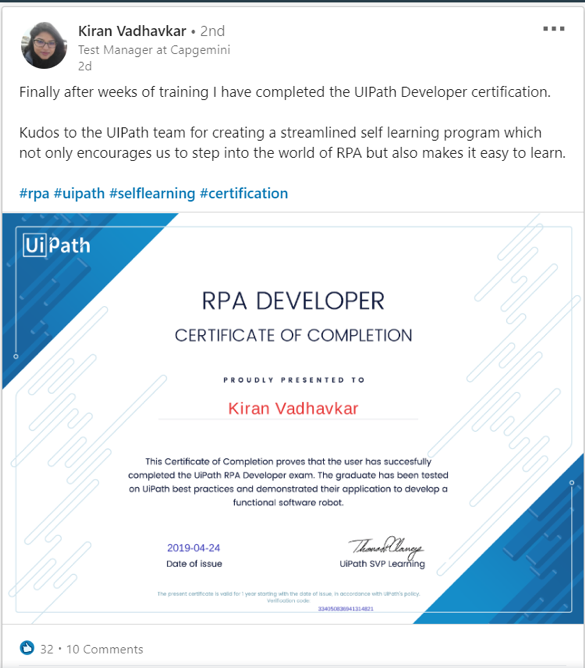RPA and The Internet of Things

It’s a phrase you hear more and more in today’s global, technology-driven business landscape—the Internet of Things (IoT).
But, what exactly is the Internet of Things? As defined most simply by the business publication Forbes, IoT is “the concept of basically connecting any device with an on and off switch to the Internet (and/or to each other)...if it has an on and off switch then chances are it can be a part of the IoT.”

The Internet of Things is only growing as the number of connected devices grows and the amount of machine-to-machine communication increases. It’s being adopted by many industries across numerous verticals and can include, for example, wearable devices, mobile devices, industrial equipment, intelligent businesses, and even smart homes.
It’s important to understand the Internet of Things is not just another industry buzzword.
According to Technavio, IoT is expected to grow 31.72% each year until 2019. What’s more is that this growth is suspected to continue long-term: according to GE, the Internet of Things is capable of contributing a total of $10 to $15 trillion to the global GDP within the next twenty years.
The concept of IoT and the 24/7 connectivity of devices to promote data and information sharing has transformed a number of industries in streamlining business processing and optimizing efficiency. The ability of Robotic Process Automation (RPA) to enhance back office, repetitive tasks via automation makes the platform a prime candidate for inclusion in IoT.
To get a better understanding of how IoT and RPA can function together, we’ll examine the ways in which RPA and the Internet of Things can foster collaborative, efficient business processes.
RPA and IoT: Double the transformation
The global management consulting firm McKinsey and Company sees IoT developing in two main areas, especially as both businesses and individuals move to embrace more interconnected futures.
The first is improved “information and analysis,” which results from the increased number of connections that the Internet of Things allows between products and business operations. Imagine, for example, that a company can, through the use of sensors and actuators, accurately track products as they travel within the supply chain or even monitor the physical movements of customers as they browse a retail store.
Arguably, however, IoT is making the most transformative strides in the second area of “automation and control.”
As an automation platform, RPA has the abilities to help manage all of these capabilities that IoT now makes possible.
The “intelligent” company previously mentioned must manage notifications — whether flagged events or problem alerts — that are triggered by the sensors. Without the use of RPA, these activities are repetitive and are highly dependent on employees working in the back office to manage them.
However, companies can use RPA software robots to easily manage and address such alerts. This might mean, for example, that all alerts are compiled into a central database, flagged for employee attention, or even used to trigger another event, such as sending a confirmation email to a customer.
RPA and the Internet of Things: Expectations
Whether used within the supply chain or a retail space, this kind of collaboration between RPA and the capabilities of IoT can provide transformative benefits for many businesses. Together, IoT and RPA can help drive:
Improved data management: In our increasingly digital and interconnected world, the amount of captured data grow exponentially, especially considering the rise of IoT.
Through the use of RPA, companies can turn large volumes of unstructured data into meaningful, patterned analytics. RPA can be leveraged to gain information about internal business dynamics, both in the back office and the front office. This can include, for example, the number of transactions software robots have completed, the transactions that generated exceptions, and the time required to complete certain business activities.
Autonomous responses to events: While not yet comparable to complexities of decision-making by humans, RPA is already capable of executing routine tasks without the need for human intervention. However, through the use of such automation, IoT involves rapidly and efficiently responding to unforeseen situations, such as a bottleneck within a supply chain.
As a result, the combination of these two technologies is delivering enhanced performance in responses to unexpected business events.
Operational optimization: RPA and IoT can lead to the optimization of both processes and resources. By providing ways to access new business intelligence and the ability to manage it, these technologies can allow companies to drastically improve the quality of their output, whether this entails providing more prompt customer services or better managing how products travel through the supply chain.
As can be seen here, IoT will have a significant impact within the world of automation, especially on the realm of data management, software robot autonomy, and operational optimization.
These attributes allow companies to develop more streamlined business practices over time and foster operational efficiency. This means that not only will companies be able to focus on their own development and growth, they’ll also be able to spend more time developing lasting relationships with customers and clients, a fundamental component of a successful business.
RPA and IoT: The endgame
With the adoption of every new technology are challenges that adopters must face, and the same can be said of IoT and RPA.
Currently, only the most pioneer and trendsetting of companies are leveraging the benefits of these technologies. Even in our increasingly modern and technologically advanced age, not all companies have the resources and capacity to take advantage of RPA and IoT.
Two of the biggest challenges posed by IoT are security and costs: connected devices and sensors are still costly, especially for individual users and small businesses, and the risk of hackers accessing private information is still existent.
However, despite these initial roadblocks, the technologies behind IoT and automation are positioned to make great impacts and to eventually become commonplace in even the smallest of companies.
As both technologies become more widespread, the challenges associated with the two technologies will drastically subside: the investments required to become an adopter will significantly decrease and more robust security precautions will also follow along. This means adoption will become more widespread and the capabilities and applications of RPA and IoT will increase along with it.
Learn more about the future of automation in the "automation first" era.

Content Developer, Trekk
Get articles from automation experts in your inbox
SubscribeGet articles from automation experts in your inbox
Sign up today and we'll email you the newest articles every week.
Thank you for subscribing!
Thank you for subscribing! Each week, we'll send the best automation blog posts straight to your inbox.



